Mitigating
Social Inequality
Inequality is a complex issue that is ingrained in all levels of society across all regions of the world. It is caused by a multitude of interconnected factors that affect almost every aspect of our lives. The attempt to understand and let alone mitigate this issue has been a challenging, but incredibly interesting task for our multidisciplinary team. This website showcases the results of our attempt to model and mitigate this wicked problem.
The Leverage points of Inequality
Even though the causes for inequality are limitless, determining and grouping its root causes allowed us to identify six key leverage points, which are the categories that encompass the most recurring requirements throughout the entire system. Acting on these leverage points will have the biggest impact on inequality.
Formalization of Social Structures
The implementation and regulation of policy around social structures such as governments, communities, and families. This aspect largely determines the access to social support systems and hence, security.
Knowledge Production
The ability, resources, and motivation to initiate new developments and conduct research. This aspect promotes innovation and development of new solutions directly increases economic success.
Knowledge Distribution
The multi-faceted process of sharing, acquiring, and digesting new knowledge and skills. This supports personal and professional development, increasing one’s potential value to society.
Distribution of Goods
The allocation of goods to the end user. This allows individuals to specialise and share commodities, improving efficiency and with this availability for everyone.
Production of Goods
The ability and resources to develop and produce goods, from primary resources to advanced technologies. This directly supports economic development, human survival and financial success.
Infrastructure
The main systems society needs to function, such as mobility, sanitation, and digitalisation. With proper infrastructure, the societies can stay connected and most important goods can be distributed.

Mitigation strategies
We created 5 mitigations which are advice, proposals, or prototypes of interventions that can be carried out to mitigate the effects of inequality in different areas of the global socio-economic system of inequality.
Accountability of Municipalities
Considering all citizens in decision-making for policies is vital to tackle inequality. Especially on a local level, municipalities should attempt to involve their citizens in the decision-making process. This mitigation is an advisory report for the municipality of Rotterdam on how accountability in the municipality can be increased.
Objective Media
Objective Media
The internet contains a lot of information. It can be difficult to review the validity of information, news and their sources, which creates inequality and imbalances power through the current centralised system. This mitigation uses blockchain to check, verify and cross-reference information in a decentralised manner, making it easier to rely on the information provided.
Education for All
Objective Media
Children with disabilities have a lower chance at going to school. Students with autism are impacted through the lack of adjusted guidance in high school classes. This mitigation is a coursebook which uses their strength and with this helps them thrive in high school.
Nutrition & Brain Development
Nutrition, despite being often neglected, is vital for brain development and therefore for one's future. However, an appropriate daily intake of food can be difficult, especially for those with a low economic status. This mitigation proposes an app to help with monitoring food intake and providing guidance in how to improve nutrition.
Fair Fashion
Objective Media
The creation of fast fashion produces a lot of waste, emissions and exploitation. Majorly, third world countries are left with the waste and work for low wages because of the underdeveloped regulations. This mitigation proposes mass customisation to allow for workers, customers and companies to work together and be more (socially) sustainable.
Connections
Through the circularity of the system and feedback loops between the mitigations we created, they do not act independently, but rather influence each other to create compound effects throughout the whole system.
Conclusion & Outlook
We were determined to understand the system with an approach that is applicable to every society, time, and geographical location. This approach yielded important new insights and we created a unique framework which can be used by others to improve strategic efforts towards a fairer world.
Modeling Inequality
The team started off by creating a map plotting the aspects of social inequality and their relation to one another. Even though this was done extensively, due its wickedness, the map will never fully encompass all aspects of inequality.
Explanation & Examples of the Model
The model created, thoroughly investigates the relationships and factors influencing inequality in fulfillment of human needs. This was done in a cascading manner and can best be understood using an example. The following section explores a small part of the model, starting with the fundamental need of food.
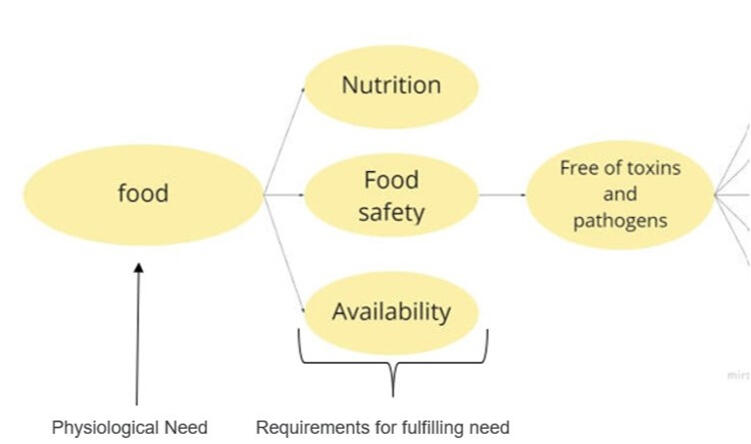
Food is an essential physiological need, and the three aspects branching out from ‘food’ are the needs, or requirements, to ensure that the need is met optimally. For the sake of providing an example of the mapping, we will follow the ‘food safety’ path. As shown above, food safety can be achieved when it is free of toxins and pathogens, which in itself requires several aspects (see below)
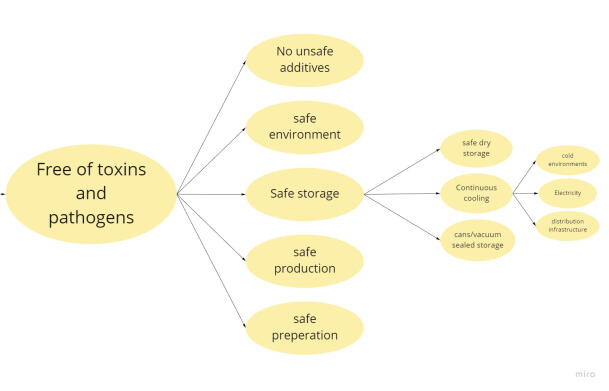
Again, for the sake of simplicity and explanation of the concept, we will follow the “safe storage” arrow.

An important requirement, or need, to ensure that food is free of toxins and pathogens is ‘safe storage’. As seen in the steps above, there are three identified requirements for safe storage. From that, we follow the ‘continuous cooling’ path, which is a requirement for many foods to stay fresh. This leads to a few more requirements, one of them being electricity.
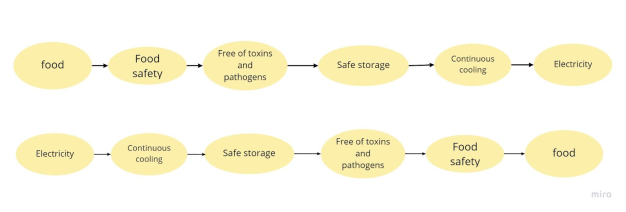
Above, the example we followed is extracted and presented as a single line. This demonstrates that we can either start from the fundamental need, in this case food, or we can start from the end requirement and follow the path back to the fundamental need.The former shows requirements to achieve the need for food, the latter shows how differences in the access to electricity can result in differences in satisfaction of the need regarding food. Using the logic described in the previous steps, we analyzed all the identified needs and requirements, mapping all aspects as detailed as possible.This resulted in a very extensive and complex map. Despite the intricacy, we were able to identify patterns and extract the most relevant variable groups. As can be seen in the map, several variables, for example ‘access to water’, occur repeatedly throughout the map, showing their importance. These and other similar variables can be grouped together into overarching categories, such as infrastructure or access to commodities. This allowed us to determine 6 key leverage points, which describe the root causes for inequality in all of Maslow's needs.
About the Project
Upwards of 80% of one’s life chances are determined by factors over which one has no control (McNall, 2016), leading to large inequalities in the opportunity to fulfill one’s needs. As a structural and widespread issue affecting all of us, inequality has an often underestimated cost to society. It increases social unrest, destabilizes democracy, decreases economic output (Cingano, 2014), and imbalances the distribution of food, education, and medical care (Islam & Winkel, 2017). Experts additionally speculate monetary costs of over 23 Trillion Dollars within the last 30 years in the US alone (Buckman et al. 2021). And as inequality increases, those costs are only expected to grow with it.As a problem which has no definite formulation, whose solutions are good-or-bad instead of true-or-false, and being unique in its quality, inequality is a perfect example of a wicked problem (Rittel & Webber, 1973). It simultaneously requires a multidisciplinary approach and targeted expert solutions. As a truly interdisciplinary team with experts from a variety of fields, this seemed like the perfect challenge for us. Setting out to attempt this impossible task, we defined the following mission:
“Gaining a holistic understanding of the causes, effects, and reinforcing factors
of social inequality to develop concrete, sustainable mitigations.”
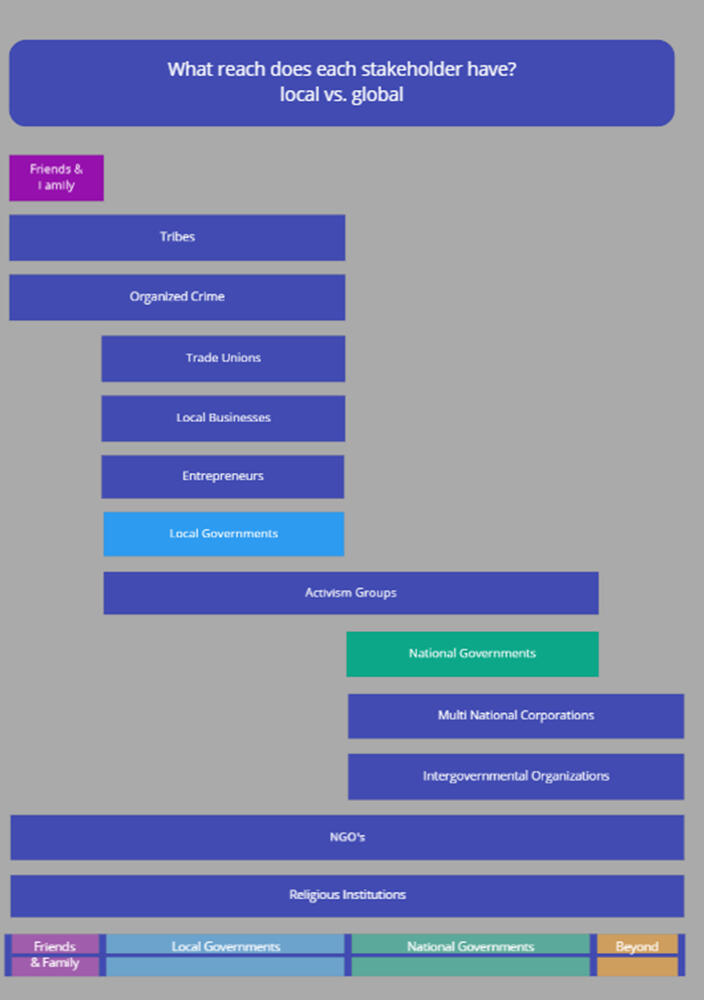

To tackle this mission, we will provide a framework and concrete strategy advice, which can support and inspire organizations and individuals fighting for a fairer world. The framework provides a map of the issue, to show connections and enable a thorough system analysis. This will not only allow for the development of effective mitigations, but also acts as a tool to identify possible side effects showing the sustainability of the proposed solutions. Sustainability in this case refers to the prevention of resource exploitation, negative effects in the bigger scope, and increasing societal costs.As everyone affects and is affected by social inequality, essentially the whole world is our stakeholder. Providing an overview of all stakeholders is hence impossible. Therefore, we have created a comprehensive overview of the stakeholders, which are currently most affected by the societal costs and most active in finding solutions. This was done by grouping them based on the scope of their reach, which gives clear guidelines who to involve when designing for a specific scope.After our initial brainstorming phase, we quickly realized that due to the arbitrary definition of inequality, our cultural, and socioeconomic background introduces heavy biases. However, to make an impactful and ethical contribution to the presented problem applicable on the global scale, the map of inequality should be created using an unbiased and value-free perspective. Therefore, we utilized Maslow's pyramid of needs (Maslow, 1943) to develop a conscious and systematic method to create a map, which minimizes biases and objectivises the issue.Maslow (1943) developed a framework describing human needs across all cultures and geographical locations. Maslow explains that these needs can be divided into four different subgroups: (1) physiological needs, (2) safety needs, (3) belonging and love needs and (4) esteem needs. Once those are satisfied, he suggests that the ‘ultimate goal’ of self actualization can be achieved.The aforementioned needs are perceived as universal and bias free, so we decided to base our analysis on this framework. Accordingly, we defined inequality as “the difference in one’s chance to satisfy Maslow's needs”. Analyzing the factors, which ease or oppose satisfaction of those needs in a thorough and cascading manner,
allowed us to find the root variables which ultimately determine the ability to pursue one’s goals and dreams. Grouping those root variables allowed us to define 6 overarching themes, building the key leverage points in the system of inequality.Once we gained a holistic understanding, we separated into groups of 2-3 students, each developing a mitigation plan addressing at least one key leverage point. The topics were chosen based on the background and interest of the individual group members to effectively leverage their expertise. More detail regarding the relation of the mitigation to the overarching problem can be found in the mitigation subpages.
Accountability in Municipalities
Participation in Rotterdam as a case study
Rotterdam is a city in the Netherlands that experiences high degrees of social inequality among its citizens (AlleCijfers, 2022; Gemeente Rotterdam, 2022). Vulnerable citizens, those more likely to experience social inequality, are frequently less included in decision-making processes (Arnstein, 1969). To solve this, the municipality can be a powerful actor, by reformalizing their social structure and increasing their accountability. Increased accountability can positively influence safety and physiological benefits, as citizens can hold their municipality accountable for safety nets, functional social systems, shelter, medical care, food and so forth.To increase the accountability within the municipality, high levels of participation of all different citizens groups is crucial (Arnstein, 1969). The presence of accountability builds trust and ensures that decisions are justified and made with careful consideration (Ammeter et al., 2004). This should allow for the vulnerable citizens to speak up and be involved in decisions that affect them and in that way mitigate parts of the inequality that they experience. Therefore, increased accountability can also lead to more developed stages of autonomy and true democracy.
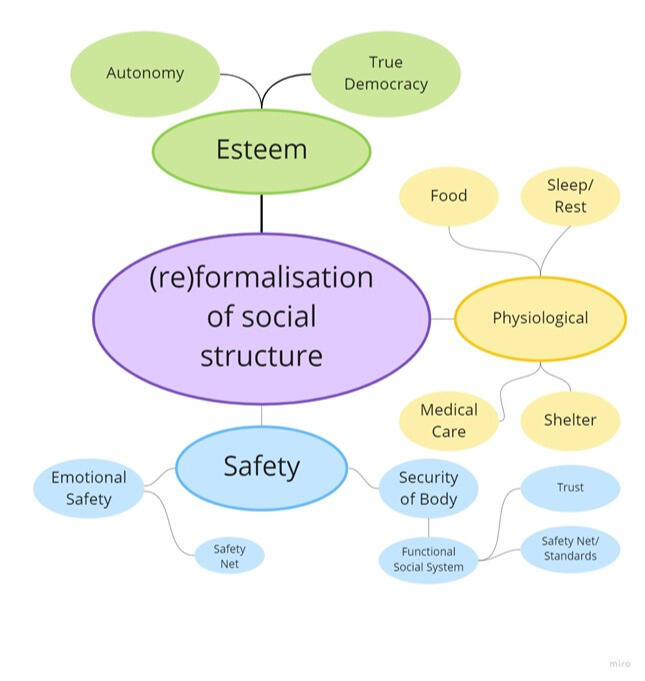
This mitigation looks at the accountability of the municipality of Rotterdam towards (vulnerable) citizens with the aim of understanding the current level of accountability and proposing advice on improving this. The outcome is an advisory report which clearly outlines steps to take to increase the accountability in the municipality. It focuses on three aspects; participation, evidence-based advocacy, and transparency & trust. It encourages having more low-scale involvement and to critically evaluate the current participation along with the provision of information of the municipality towards their citizens. The increased transparency and decision-making on the basis of concrete evidence will likely increase the trust of citizens which will result in higher participation, creating a positive feedback loop (Jin, 2013; Lee & Schachter, 2018; Schmeets & te Riele, 2014; van Buuren et al.,2022).
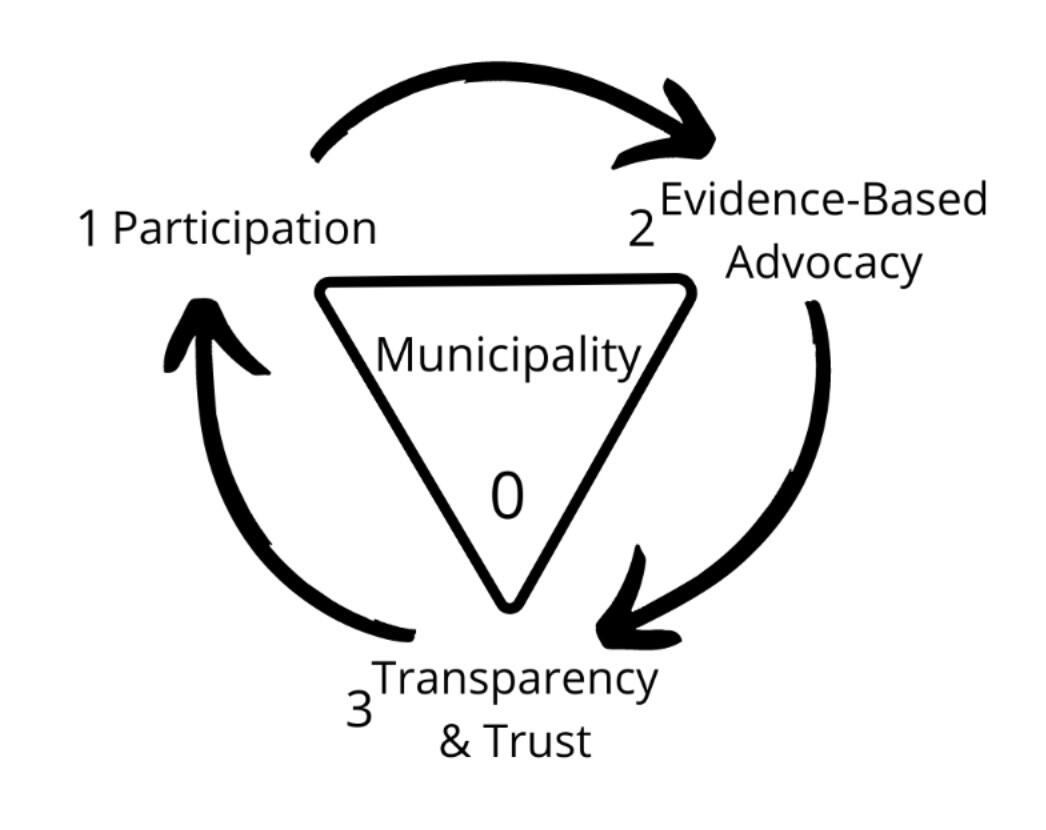
Strengths
Higher level of citizen participation in municipal decision-making
More power in (vulnerable) citizen’s own hands
Increased trust in the municipal government
Positive feedback loop for participation and trust in the municipality
Higher accountability within the municipality
Possible limitations
Need for time, resources, and capabilities of the municipality (which is scarce)
Might harm other objectives of the municipality through a shift in focus
Implementation of this plan first requires more direct contact with the municipality of Rotterdam
OutlookFollowing this mitigation, Rotterdam is encouraged to review and implement the advice. In this process, the consequences and observations should be accessible to all citizens. If the outcome seems to be generally positive, the steps taken to reach the current advice can be generalised. A framework that guides the municipality in evaluating the current system and formulating actionable strategies based on the evaluation can be created. This framework could then be applied to other municipalities, allowing to extend accountability and positive feedback loop of participation, evidence-based advocacy and trust between the municipality and their citizens beyond solely Rotterdam.
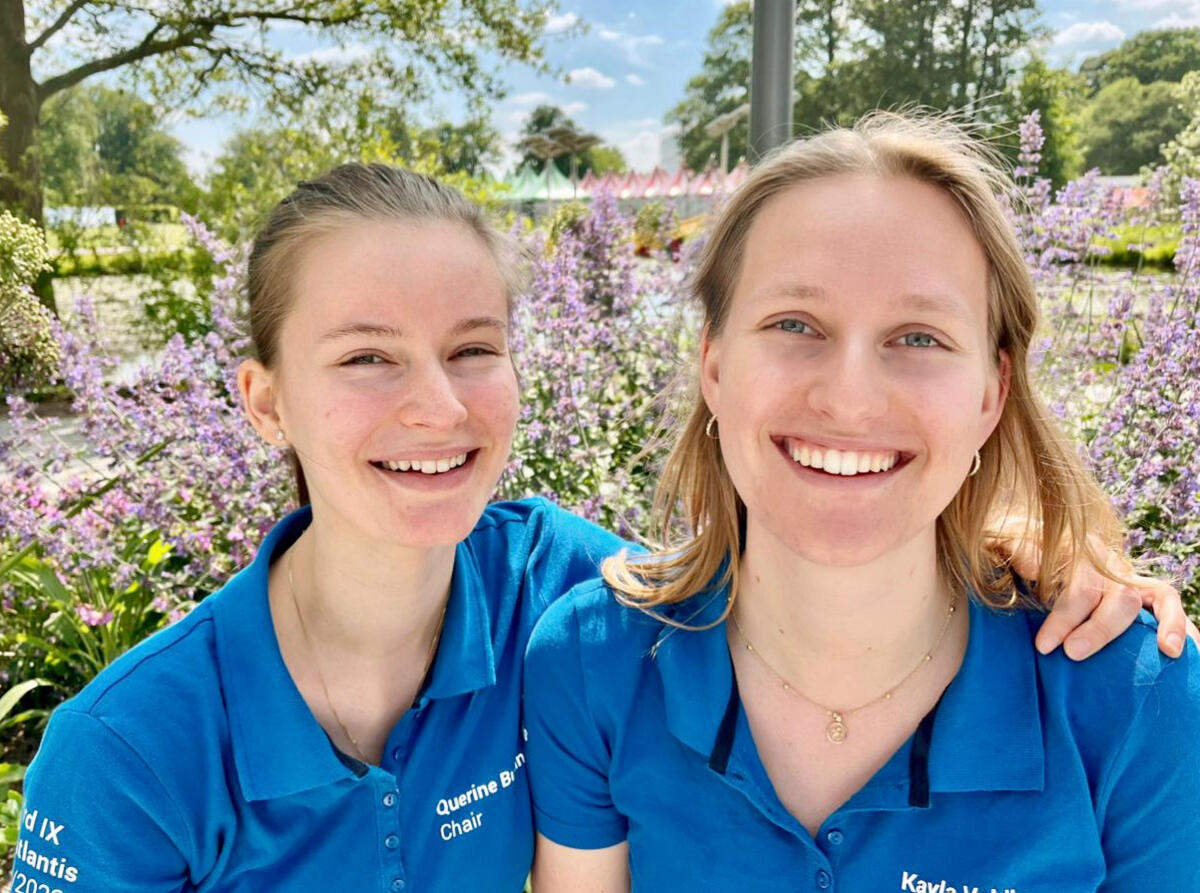
Kayla Veldkamp & Querine Buiting
Objective Media
Link to inequality
Knowledge production and knowledge distribution were identified as two of the main recurring themes in our analysis and were common to multiple factors that could prevent inequality across a range of human needs. This mitigation proposes the development of a tool which enables more transparent and objective media and more critical reflection on the presented information. This increases equality by allowing people with lower levels of education and or critical thinking skills (correlated) to read news articles with a more critical eye. People who have not developed critical thinking and research skills in a formal setting still need the ability to engage critically with what they read and be aware of the assumptions that exist in news articles. Our tool would mitigate the knowledge imbalance between people with and without formal education in terms of critical reading skills. Journalists and new outlets, intentionally or otherwise, inject their own values and biases into their work. Hence, the broader goal of our tool is to enable people of all backgrounds to make the best decisions based on their own interests, without undue influence from these external parties. Working backwards from the recurring themes in mitigation of inequality, this solution can improve both the physiological and esteem needs of individuals. This can be seen in the map below.
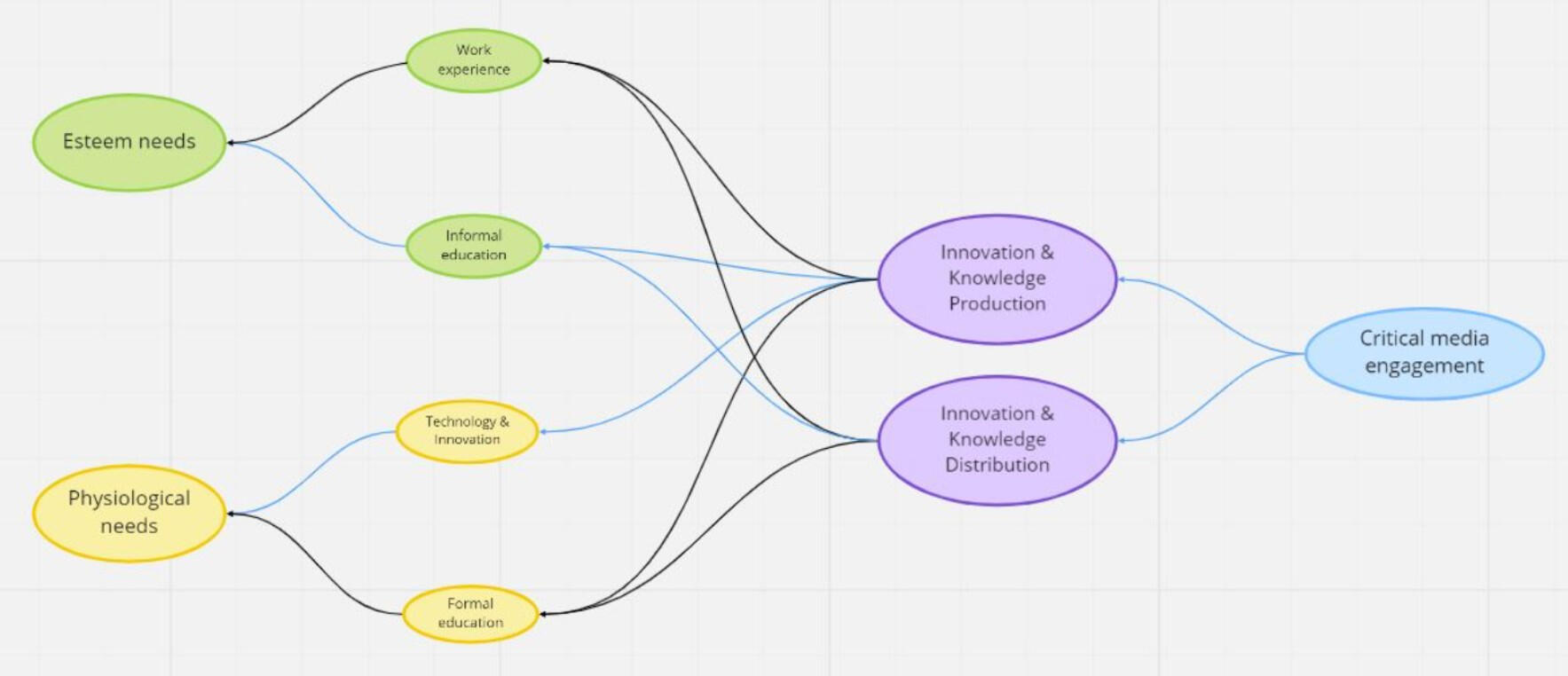
Explanation of the mitigation
This mitigation consists of a tool which enables more transparent and objective media. It supports journalists to provide more objective and fact driven narratives and allows consumers to critically reflect on presented information. Because the target users are people with low formal education, the user interface should be extremely intuitive and anyone should possess the skills necessary to use this tool. Hence, mock-ups were made to show how the tool could be deployed in a way that did not interrupt engagement with the original text, and simply placed extra information at hand for the reader’s consideration. To do so, a concept which utilizes blockchain technology and language processing AI were developed. Blockchain technology refers to a distributed database that is verified by all users in the network. Language processing AI refers to an artificial intelligence which has been trained for the analysis and interpretation of natural, in this case written, language data. This concept in question uses both of these technologies to allow decentralized verification of data and improve transparency regarding the values and assumptions shaping media narratives. Providing both a text editor for journalists and a browser plugin for readers simultaneously elevates the creation of objective news and the ability of readers to identify manipulative, biased, or false information. This final product is specifically catered for Publishers, NGO’s and Browser providers.
Strengths
Facts are verified independently by organizations
Giving readers greater insight into day-to-day news and politics by fostering better understanding of content
Giving the ability to the average citizen to assess news on the go critically
Giving a warning system for highly uncredible texts
Providing authors with a tool to aid in quality writing (provision of credible sources and revealing underlying assumptions & wording)
Provide a tool for authors to show the credibility of text to readers
Possible limitations
Writers could abuse the tool to make their text seem credible via the tool creating false security.
Writers could drift into the habit of only reading the provided summary for a source (by the tool).
Not easy to get a widespread use of the tool (critical for crowd verification)
Users could trust the tool before they have developed their own critical thinking skills
The data network with nodes similar to blockchain does not exist yet (according to experts)
The tool does not cover video content, which is a media used often for “low-key fake news” We would need to implement a tool to distinguish manipulated videos and to verify the origin or interpretation of videos and photos
Outlook
Despite the current limitations, we believe this project has the potential to make a significant impact on our society. Supporting the search for objective truth, it enables a more reflective approach to current events and their evaluation, stimulating an open conversation about what is right and wrong and how we can positively affect the world we live in. The next steps in bringing this to fruition would involve addressing the identified limitations and the development of the underlying principles for data verification and assumption-checking. The former could, for example, involve investor backing for a marketing campaign aimed at promoting use of the tool, and hence improving crowd verification. The latter is a complex process that would no doubt raise many interesting philosophical and epistemological questions for the consideration of appropriate experts. For example, what is the best approximation of objective truth? And if we had it, would people want to engage with it, or would they prefer to simply confirm their own biases? Then, more technical experts would be needed to develop a decentralized database for the information that the tool would provide, as well as the language-processing AI that would populate this database from the internet and allow the tool to evaluate articles.
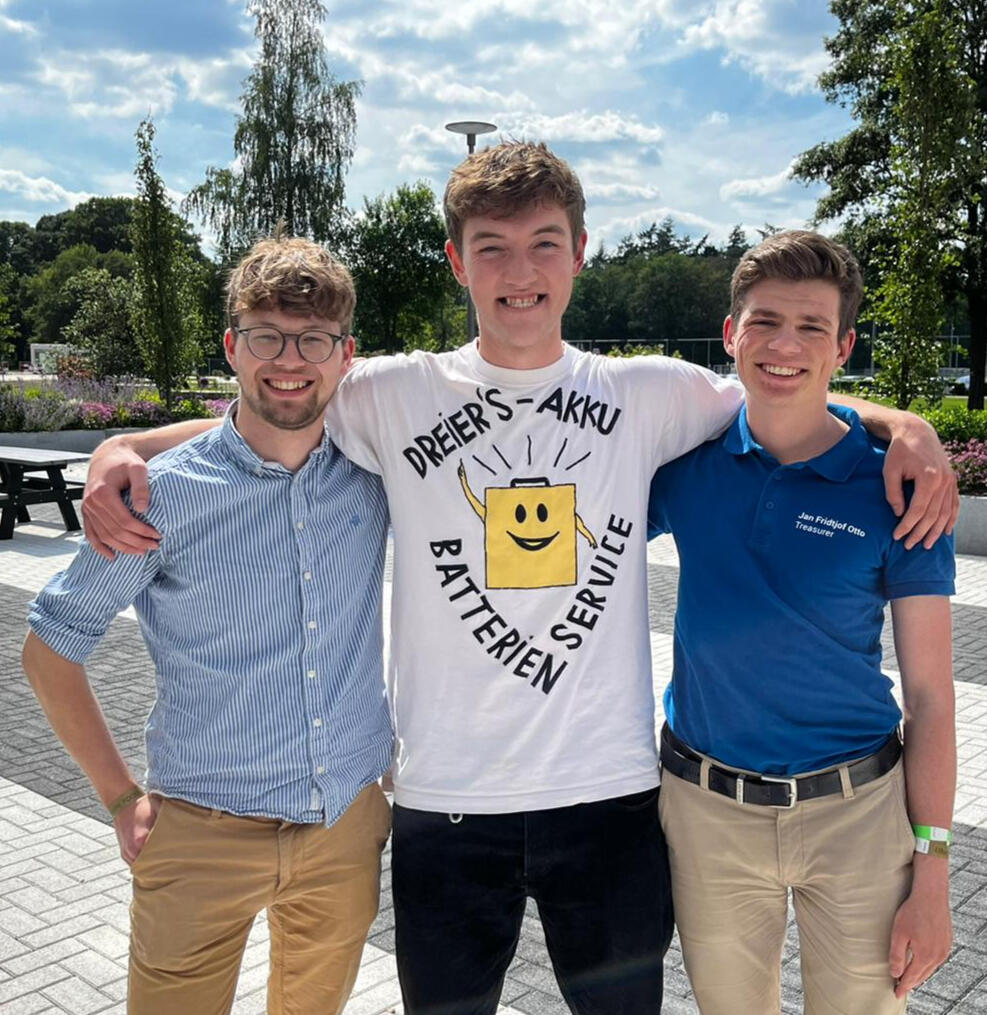
Isaac O'Sullivan & Kaspar Rothenfuẞer & Fridtjof Otto
Education for All
Making Education Accessible for Students with ASC
Link to the key leverage point of knowledge distribution
Knowledge distribution is one of the key leverage points in tackling inequality. Within knowledge distribution, education is an important factor. Currently, education is not always accessible by different groups of society equally.
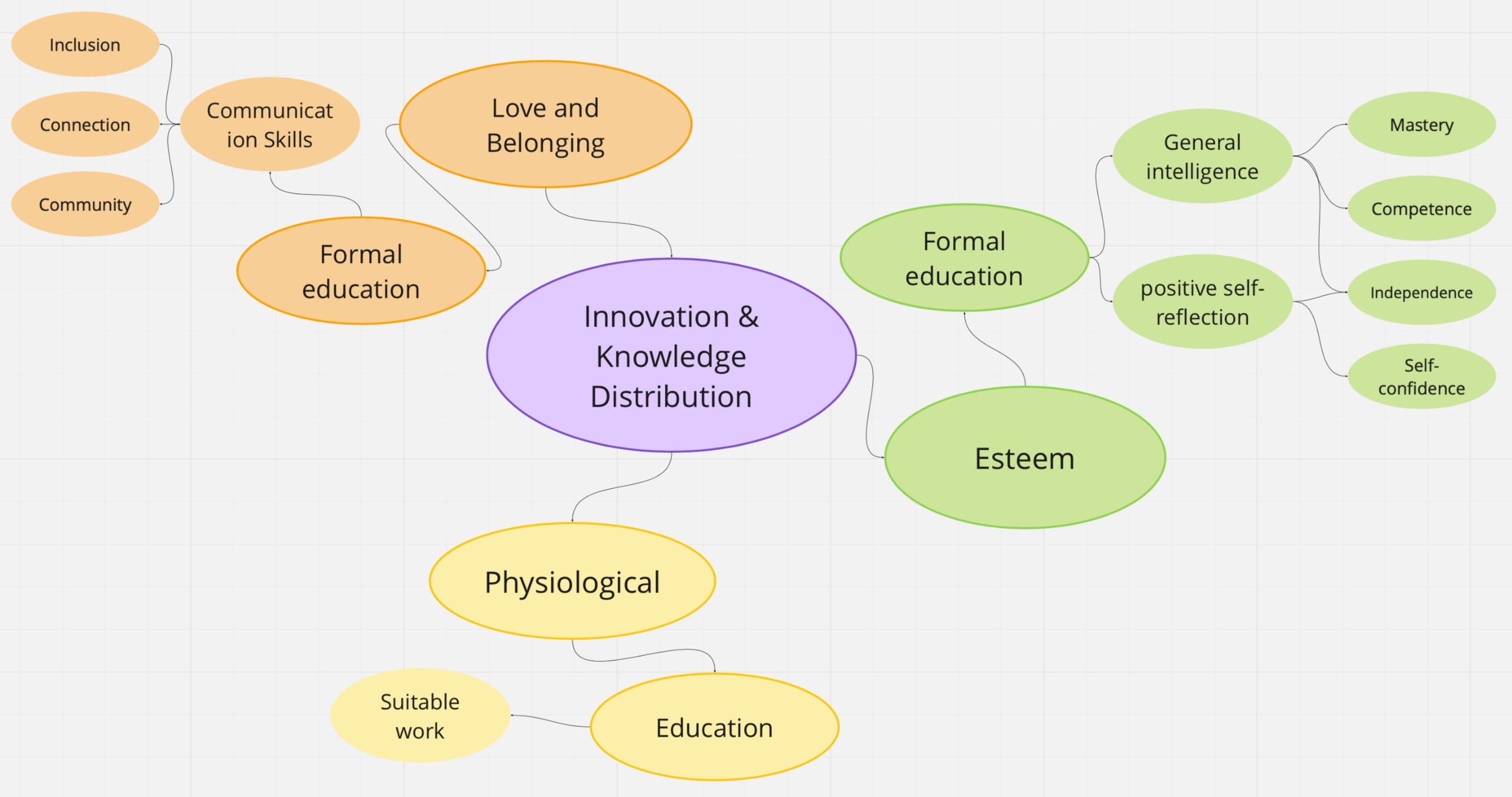
In the map of maslows needs education is important in many places. It has direct effects on three out of four levels in Maslow’s hierarchy of needs (Maslow, 1943), in which education has an effect on many subparts. The small map above shows the needs that are most directly linked to this mitigation.
Using interests to fight disinterest
In the Dutch high school system, students with autism spectrum condition (ASC) struggle to keep engaged with courses they are not interested in, causing them to follow education at a lower level or even drop out of school (Boer and Simpson, 2009).Through an interaction technology, this mitigation aims to help students with autism spectrum condition (ASC) stay and thrive in high school by using one of their strengths: their extreme focus and motivation for a topic that interests them (Wood, 2019, Lanou et al., 2011; Charlop et al. 1990). This mitigation is an online coursebook in which assignments can be adapted to the student's interests. The coursebook is an online learning environment in which some mathematics assignments get altered to the interests of the student. The question still covers the required mathematical skills that the student is learning, but also creates a better connection to their world and will help them see the relevance of mathematics to their interests.
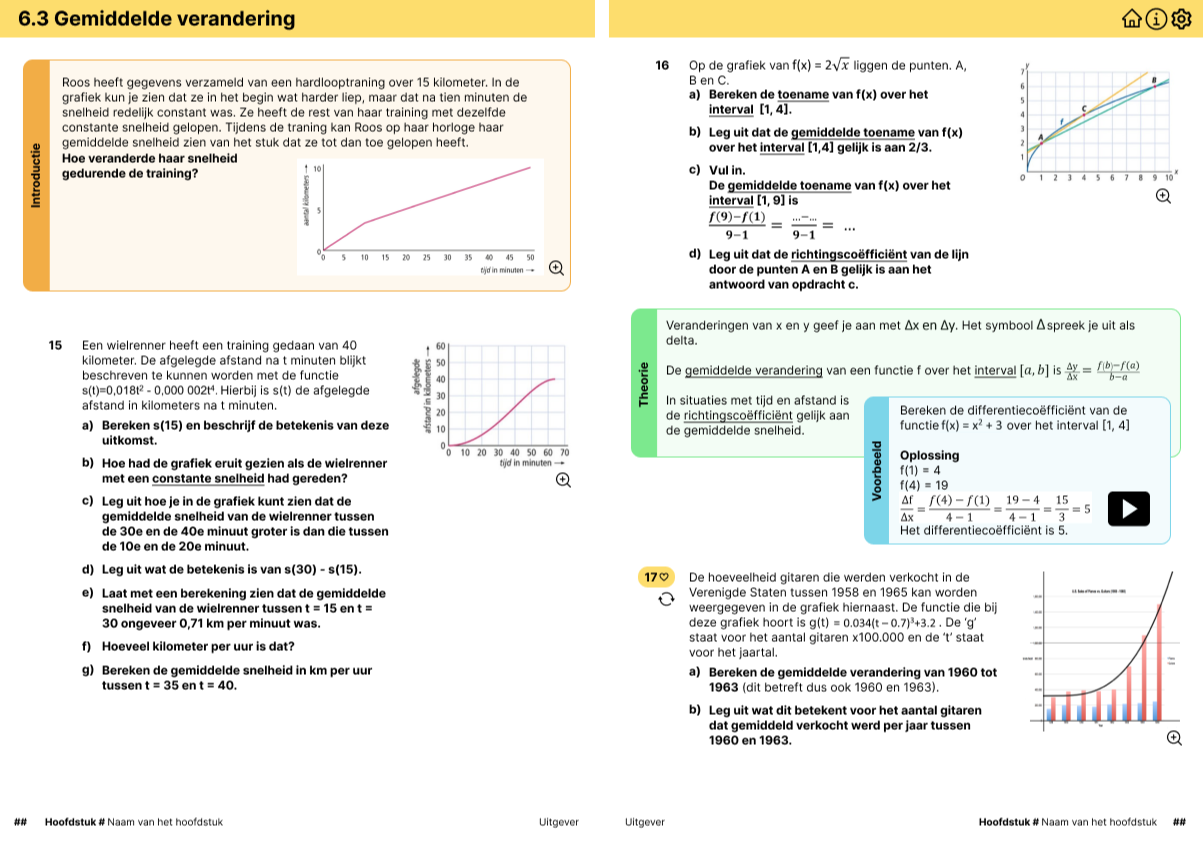
Strengths
Adjustable to students with ASC to fit their needs
Uses the strengths of the students (their focus on a topic of interest)
Bridges the inequality gap without giving an extra advantage over ‘typical’ students
Available for all students
No big changes required to the educational system → easy to implement
Possible limitations
Creating the questions requires a lot of time and effort
More research needed into the effectiveness of the mitigation
This mitigation only applies to a certain subgroup of students with ASC, as there are different levels of severity of ASC.
Outlook
This mitigation is only a design and pilot of the coursebook. No testing has taken place, which would be the first step to further develop this mitigation. After critical analysis and iterations, a publisher will have to develop the coursebook for actual use, starting with one course and hopefully extending to more courses. If all of this happens, this mitigation will make it easier for all students, not only students with ASC, to follow education and see the connections of courses to their world.
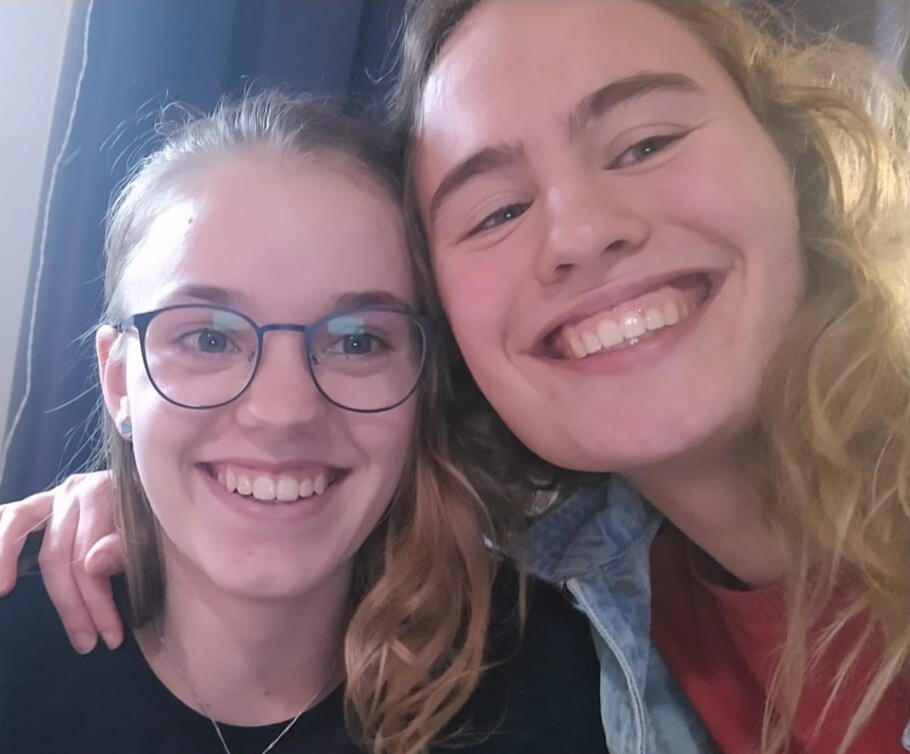
Merijn Janssen & Loes Henstra
Nutrition & Brain Development
Low economic status and its impact on brain development
Inequality in socioeconomic status is one of the most pressing issues the American society is dealing with (Neill, 2012). A child who is growing up in a family with a low socioeconomic status tends to be subjected to worse health, impaired psychological wellbeing, and their emotional and cognitive development throughout lifespan will be flawed (Mariani, 2017). As a result, there is a difference in cognitive and achievement measures between children from different socioeconomic backgrounds. Nutrition is one of the factors that mediate these socioeconomic differences (Jednoróg et al., 2012). This mitigation is separated into two parts:1. An addition to the currently exiting sexual education class given in high school in which the seed is laid for knowledge on the importance of nutrition in the prenatal period and five to seven years after pregnancy (the most critical periods in brain development)2. An app that uses photo AI to make it easy for mothers to monitor their and their child’s nutrition intake. The app will also include tips for what to eat and not eat, links to medical help, and supporting systems for getting sufficient nutrition for people with lower income. The first part of the mitigation will be a source of information for why nutrition is important and will make more people use the app. The app will be the main mitigator for narrowing the inequality gap.
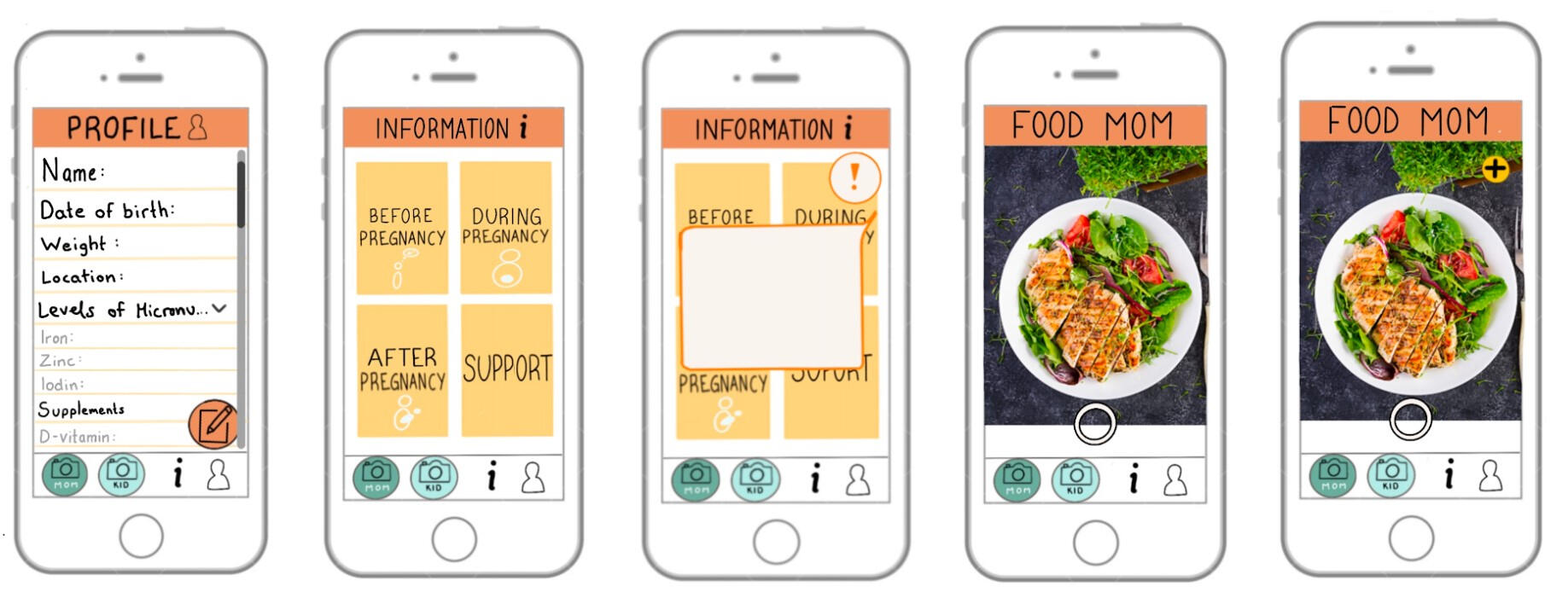
The images illustrate how the app would look. Image 1; Profile page. Image 2; Information page. Image 3; Lack of intake of specific nutrient warning over information page. Image 4; Image page for taking photos of the food the user eats. Image 5; Illustration of yellow “+” that will appear if the AI cannot recognize the food that is being photographed.
How it mitigates inequalityLooking at the bigger model of inequality, this mitigation mainly aids physiological needs. The negative feedback loop discussed before is also illustrated in the image.
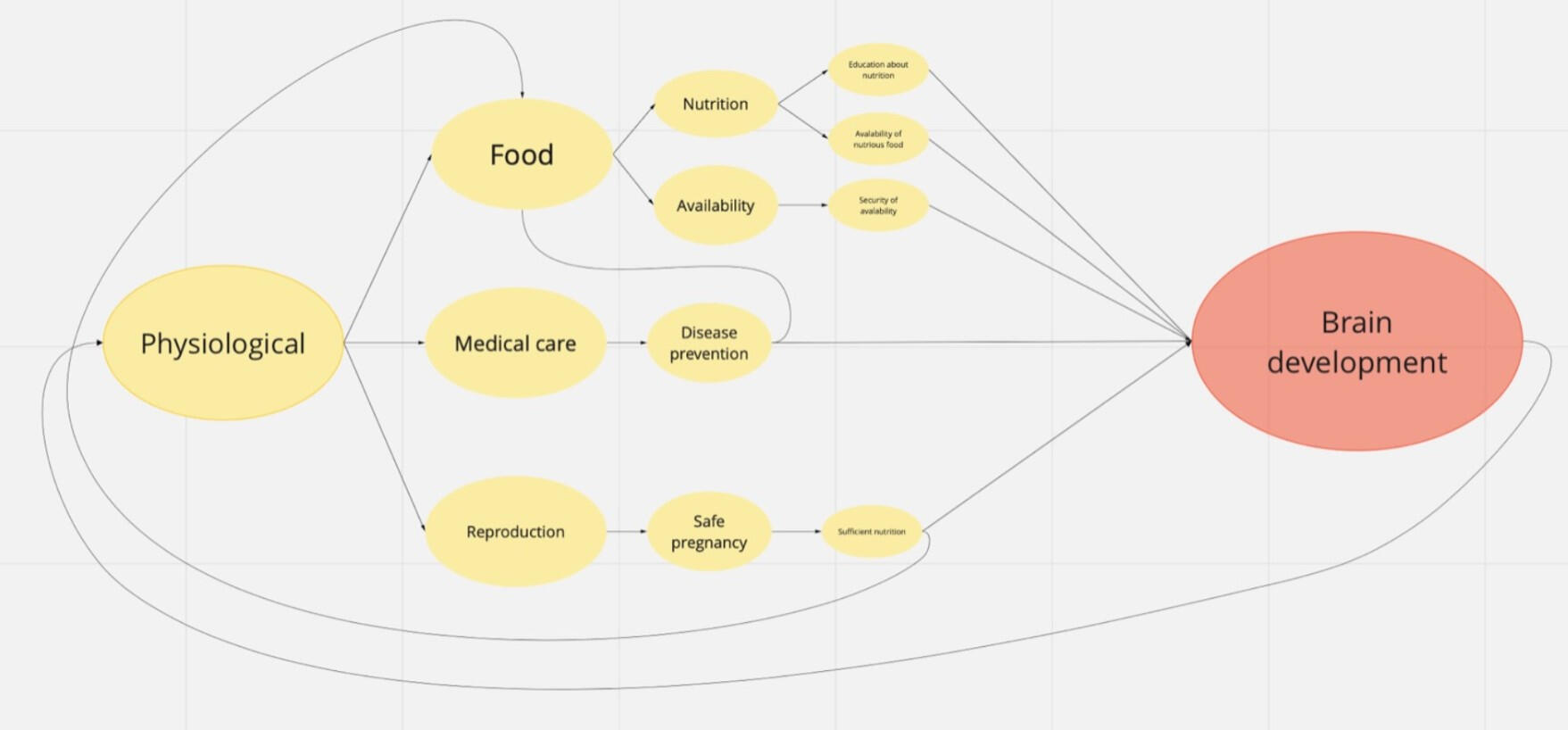
StrengthsMinimization of one of the many negative feedback loops in inequality. This mitigation contributes to narrowing the inequality gap of children growing up with lower socioeconomic status compared to those that have not in regard to cognitive development, which will also affect them, making them be able to reach a similar level regarding employment. This will also, over time, financially gain the society they are living in.
Possible limitations
For the additional information to the high school lecture, there might be teachers that have misunderstandings or misbelieves about what is important when it comes to nutrition through pregnancy and early childhood, which can impact the lecture negatively.
The focus of the app development lies in the future, and technological advancements in image recognition in AI must be developed before this app becomes reality.
The app has to be financially supported by someone to make it available to everyone.
The app only focuses on mothers who are able to breastfeed, this is a result of having limited time on the project. There are many factors that have to be taken into consideration if a mother is not breastfeeding her child.
OutlookAs mentioned above, before this mitigation can be made a reality, advancements within photo AI of foods and gathering financial support is necessary. There are also some obvious measures that must be taken, such as making sure the data of the user is secured. When this starts to take shape, it is imperative that the medical world acknowledges the importance of appropriate nutrition during pregnancy and advertises the use of this app. Since, without people using the application, the strength of this mitigation can never be realized.

Lauren van Rijswijck & Ragnhild
Fair Fashion
Connection to inequalityThe fashion industry is the 3rd biggest Industry in the world (Thelwell, 2022) and contributes to 10% of global CO2 emissions - more than flights and maritime transportation combined. It is an industry of exploitation and unsustainable practices. The Industry mainly acts on the “Production of Goods” leverage point. The main contributing factors include exploitation of cheap labor leading to up to 18-hour work days under precarious working conditions (Russel, 2020) for wages below the living wage (FashionChecker, 2020). The second major factor is the generation of nefarious chemical and solid waste that remains in the source countries, which are usually in the global south (Russel, 2020).

Explanation of the mitigationThis mitigation is a presentation to apparel brands proposing Mass Customization (MC) as a new business model to mitigate social inequality, waste generation and even climate change, killing three birds with one stone.Mass Customization is when production is based on actual demand. Customers make their own design choices and production takes place after the order is placed. As a result, attachment to the end product is increased, reducing throwaway behavior, increasing use cycle and reducing unsolved inventory as well as storage and transportation costs and CO2 emissions of the business (Dissanayake, 2020).

Strengths
Mass customization mitigates inequality while contributing to the businesses’ bottom line by reducing inventory costs, and improving customer satisfaction and loyalty.
Mass Customization approaches mitigating inequality from the demand side thus targeting the root of the problem.
Possible limitations
The main limitation of mass customization is that technologies and business processes require innovation and development in order to launch, as can be seen in the figure below (“Personalization Survey Report”, 2019).
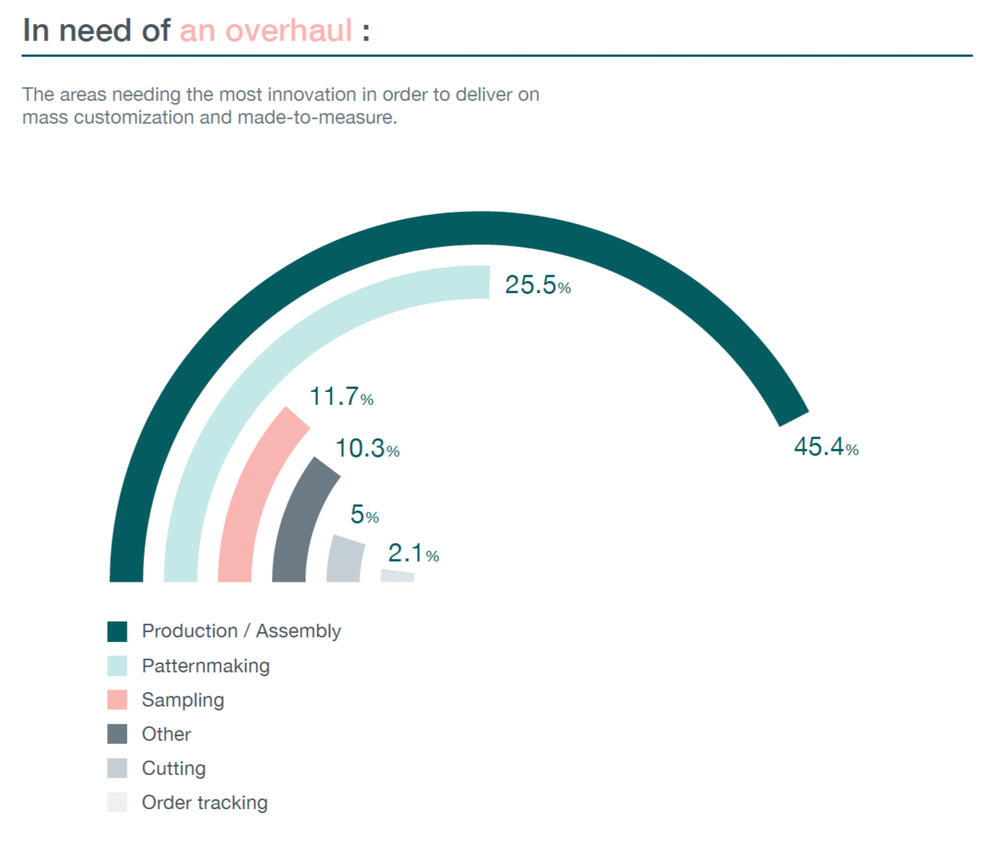
OutlookIf Mass Customization replaces Mass Production supply will be direct to demand rather than based on demand forecasts. This will significantly increase the efficiency of the fashion industry reducing its impact on the planet and working conditions. Additionally, with mass customization apparel brands will be able to cater to customers' individual needs on price, design, and functionality of products thus empowering customers personal design tastes, therefore reducing inequality not only for workers but also for customers. Join us in creating a future in which workers rights are withheld, the planet is respected and citizens are free to express themselves freely.

Pedro de Freitas Barros Neto & Perceval Fayon
Conclusion and Outlook
“Gaining a holistic understanding of the causes, effects, and reinforcing factors
of social inequality to develop concrete, sustainable mitigations.”
Countless organizations around the globe aim to fight inequality, however, so far, not many have managed to understand and map its full complexity and interconnectedness. Therefore, taking on this project was an ambitious goal. However, we were determined to understand the system with an approach that is applicable to every society, time, and geographical location. This approach yielded important new insights and we created a unique framework which can be used by others to improve strategic efforts towards a fairer world.The created map, with over 1500 data points, is fairly extensive and introduces a systemic approach to determine the causes, effects, and reinforcing factors of inequality. The model shows that the relationships between variables, and the strength and quality of those relationships, can not directly be determined. Instead, the framework is meant to be an architecture, which can be extended and quantified when applied to a specific context. When a set scope regarding location and demographic is defined, data can be used to quantify the relationships between variables and establish the ones which could have the greatest influence. Furthermore, side effects can be predicted more easily using the framework.However, even without defining a specific scope, important conclusions can already be derived regarding the importance of certain overarching factors. Throughout all human needs, certain root causes occur repeatedly. As they affect almost every aspect of inequality directly or indirectly, they build the key leverage points in global inequality. Those key pillars or leverage points are the formalization of social structures, production and distribution of Knowledge, production and distribution of goods, and infrastructure.The mitigation strategies developed by our team show that when properly leveraging the analytical power of the framework and the expertise of interdisciplinary individuals, concrete solutions can be formed. As these solutions were purposefully developed within the framework, the small direct effects are compounded by the feedback loops and downstream interactions, multiplying their impact. For example, the creation of more objective media creates better educated societies, which can develop tools that are even better at removing media biases.LimitationsWhat should be noted is that the mitigations in this project did not tackle the biggest problems or most important factors identified in the model. Instead, the mitigations were chosen according to the expertise of the students. In future situations, it might be useful to work on this wicked problem together with individuals that have expertise that are deemed necessary, by creating teams with the required expertise around the most pressing factors or leverage points.Due to the many mediating factors between different mitigations, it was difficult to assess both the quality and quantity of the influence from one mitigation on another. This could be improved by building a model which allows for data driven quantification.We did our best to map the problem from a value-free perspective. However, as this, due to our personal biases, is almost impossible, it would be useful to critically question our decisions and assumptions that have been made throughout the process of mapping and mitigating. A possible improvement would be the cultural and socioeconomic diversification of the team, as well as the inclusion of experts in the field of philosophy, intercultural differences, and similarly relevant fields.Future Outlook
As expected, this project has not resolved inequality and only confirmed its complexity. However, it yielded important insights and created a usable tool, which acts as a small but significant contribution to worldwide efforts. Looking forward, we suggest some small improvements to the framework followed by wide-scale use from a variety of stakeholders.As mentioned, the map, though extensive, is by no means complete. We therefore highly encourage others to expand it. Furthermore, it would be a useful idea to translate it into a more graspable form and add the possibility to quantify relationships where data is available.Once improved, this tool can be utilized by organizations all around the world following a similar approach done by our team. Firstly, utilizing the model, an understanding of the specific scope and the important variables can be created. Secondly, using quantitative data, the most influential variables in the set problem can be identified. This enables the selection of suitable experts, who can then develop targeted solutions which act on the identified leverage points. To do so, relevant stakeholders need to be identified, contextual factors should be analyzed, and whenever solutions are formed, possible negative impacts should be considered using the framework. Without this, separating causes and effects is too difficult, and creating impact is arduous.The strength of this project lies in its holistic approach. This allows better assessment of indirect and long-term effects. Furthermore, it creates a framework which can be used by virtually every organization, and stakeholder involved, which in this case is everyone. However, it also showed the importance of collaboration between stakeholders and stressed the importance of a systemic approach exceeding national, or corporate interest. Therefore, we created this website which will be shared via our personal social media as well as hopefully our school and teachers network. Of course, we also highly encourage you as a reader to share it with your own network.Anyone can help and all help is welcome. We hope to have inspired and motivated you to come up with your own mitigations. Together, we can create a more fair, empathic, and equitable world, one small step at a time.
Connections
Each mitigation aims to address a different aspect of the same overarching problem. As such they do not act independently but influence each other to create compound effects throughout the whole system. To better understand this we can distinguish between upstream and downstream variables. Upstream variables are those, who deliver input to the downstream ones. An example of an “upstream” problem would be lack of education, which can cause many problems such as lower income and socioeconomic status downstream, making it harder to pursue education and resulting in a negative feedback loop.This classification allows us to understand several important interactions between the different mitigations.

Objective media is situated upstream of all other mitigations. More reliable information creates the opportunity to hold municipalities, as well as fashion producers, more accountable. For example, objective media could help to improve the quality of articles written about municipalities and fast fashion companies and thus increase transparency about their practices. Furthermore, the verified data can directly be used to improve the content and increase the trust in the two educational mitigations proposed for autism spectrum and child nutrition.Accountability in municipalities is simultaneously situated upstream of both the child nutrition and autism mitigations. The decision to integrate child nutrition in the sex-ed curriculum, as well as the various governmental support systems, which are included in the proposed nutrition analysis app, are eventually directly linked to municipalities and the way they include citizens in the process. Moreover, without accountability structures in the municipality that allow for appropriate education with ASD, no improvements can be made in order to provide education for all. Lastly, research suggests that nutritional deficiencies in early childhood are connected to the development of autistic characteristics (Oommen et al., 2020). Placing nutrition regulation for babies upstream of the autism spectrum mitigation.
This upstream and downstream analysis is very useful and shows relevant interactions, although many variables are mitigating this effect, which makes it impossible to quantify the exact impact of those interactions.In reality things are even more complex, as many causes (upstream) of inequality are also consequences (downstream) of the same and vice versa, causing reinforcing feedback loops. Knowledge production, for example, is situated upstream of education since knowledge is required for education. On the other hand, education is needed to produce new knowledge, therefore creating a circularity which is what makes the problem so wicked. Nevertheless, it also shows great potential for mitigations to create a spiralling effect upwards when acting on one of the two.
This also means, that next to the direct interactions between the mitigations, they all affect each other indirectly through their contribution to the overarching problem. By reducing inequality as a whole, each mitigation acts upon the above discussed feedback loops. Thereby, it changes the baseline and context our mitigations are situated in, leading to bigger changes in the overall scenario.An interesting observation we could make when compiling the end result of all mitigations, is the important role information plays in all of them. As we live in the age of information, this might not come as a surprise, however, it must be noted as eventually almost all mitigations manipulate the access or production of high quality information as well as the way with which we communicate. For example, an app which gives nutritional information to pregnant women, or a textbook which tailors exercises to a student’s specific interests.Although we identified several synergies and interactions, we have to assume that the overall impact compared to the problem as a whole is limited. This is due to the scope and complexity of the chosen problem, which goes beyond borders, time, and values. Nevertheless, within its small scope, each mitigation has the potential to stimulate important changes, hence, contributing to a mitigation of inequality as a whole.
About the Team
Dear reader, this is us. We are 12 second year bachelor students studying at ATLAS. ATLAS stands for Technology Liberal Arts and Science and is the university college line at the University of Twente. In ATLAS we get a lot of freedom to choose electives and discover our own path. Because of this our class has people studying all different sorts of things which makes us a great team for tackling complex multidisciplinary problems, such as the one presented on this webpage. You can read more about each of our expertise under the photos.

David
David is moving in the direction of (environmental) sustainability, coming from a background in programming and industrial design. With his critical mindset, he strives to improve current societal systems and ways of living with innovative future-proof ideas and strategies.

Kayla
Kayla’s academic focus is mainly on different forms of management. While her expertise thus far has been applied more in corporate settings, she saw this project as the perfect opportunity to broaden her profile and focus on a governmental context.
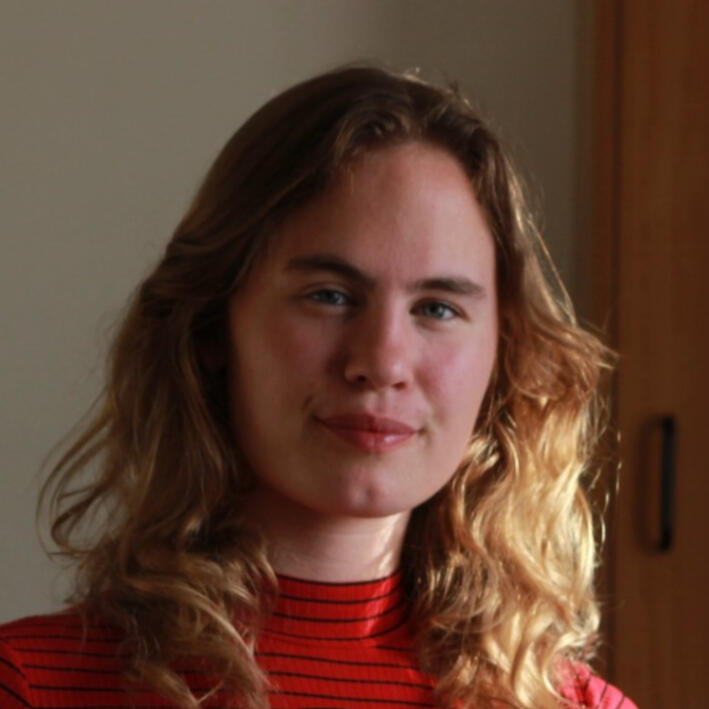
Loes
Loes is very focussed on the interaction between technology and humans. She likes to bridge the gap between the die-hard engineers and the users of technology.
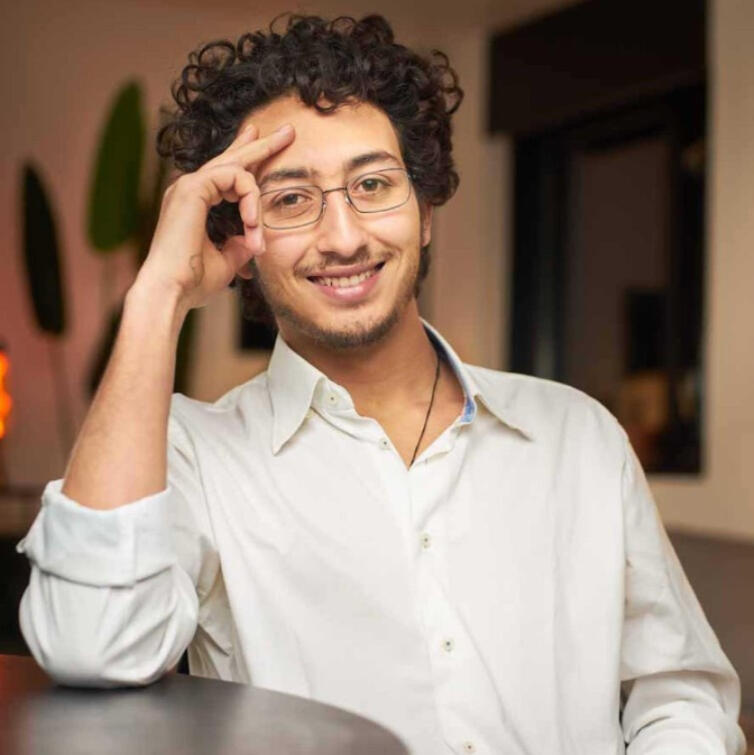
Percy
Perceval Fayon is interested in entrepreneurship and educational design, with specific interest in finding the balance between high tech and frugal innovations in these areas.
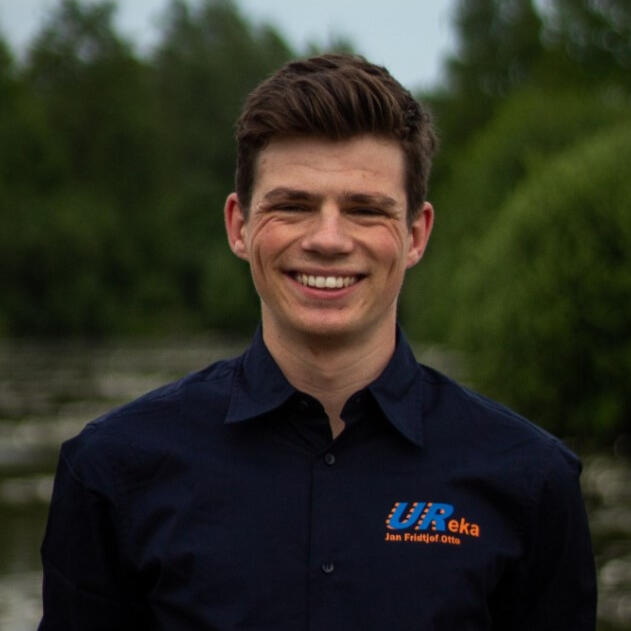
Fridjof
Fridtjof is a 2nd Year Atlas student with a specific interest in Technology assessment and Technology Policy. Therefore the Mitigation was right at the heart of his interest

Kaspar
Kaspar’s academic profile focuses on interdisciplinary collaboration and innovation. Combining knowledge and tools from a multitude of fields, he aims to develop solutions that go beyond disciplines and innovate several fields at the same time.

Merijn
Academically, Merijn focuses on education. She does however not want to be a teacher, but rather wants to develop ways to improve education, build better curricula and manage projects.

Querine
Querine’s academic profile focuses on environmental policy integration and sustainability. Her mitigation has improved her understanding of governmental processes which adds to her general knowledge and will prove to be useful in the future.
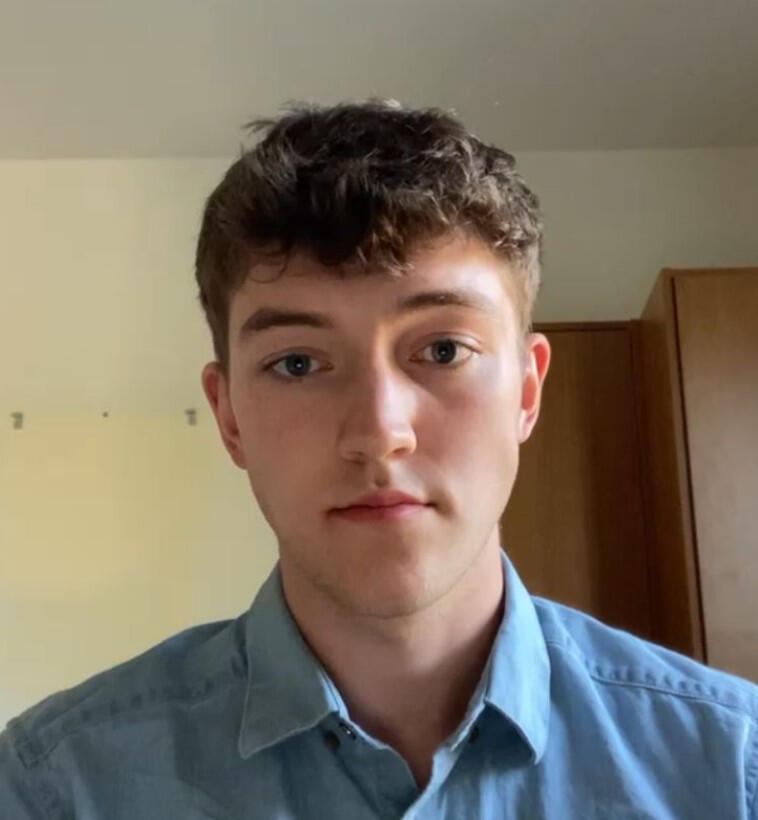
isaac
Isaac has a strong interest in interdisciplinary engineering solutions, feedback control systems, and project management. He wants to use his broad academic background to tackle the multifaceted challenges of a rapidly changing world.

Lauren
Lauren's academic profile mainly focuses on Biochemistry and Neuropsychology and how the two interconnect. She likes to broaden her profile and wants to reach multidisciplinary thinking and therefore has an interest in Nanomedicine, Biophysics, and Bio-nanotechnology.
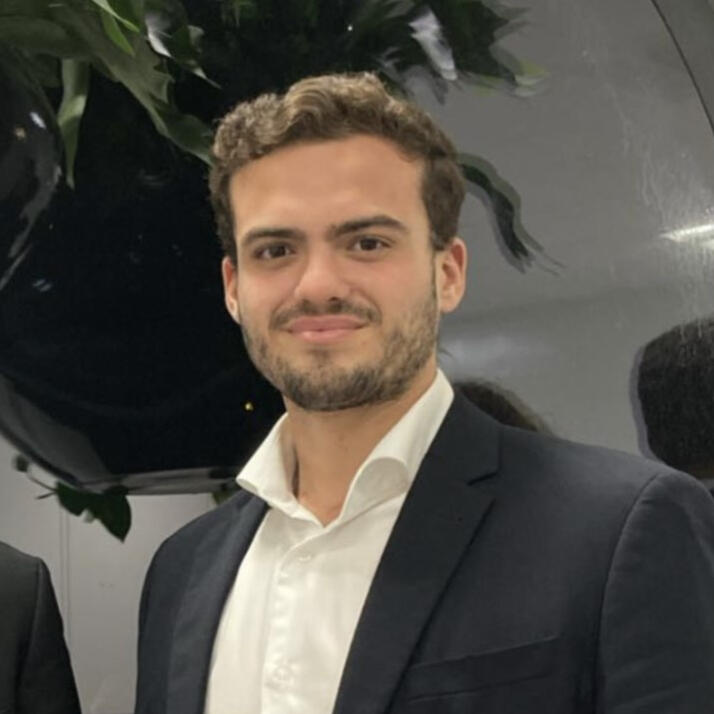
Pedro
Growing up in a developing country, Pedro is passionate about using entrepreneurship and innovation to create a better future and a better society.
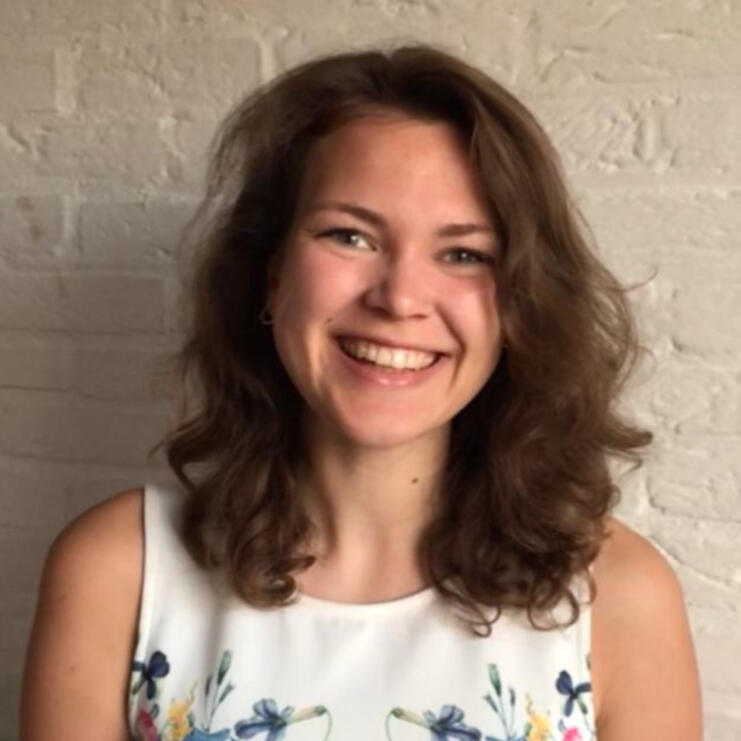
Ragnhild
Ragnhild wants to pursue a career within food science and biomaterial science. She wants to discover new approaches and technologies within these two fields while also working for and with people.
References
Place on the website
References
About the Project
Buckman, S. & Choi, L. & Daly, M. & Seitelman, L. (2021). The Economic Gains from Equity. Federal Reserve Bank of San Francisco, Working Paper Series. http://dx.doi.org/10.24148/wp2021-11.Cingano, F. (2014). Trends in Income Inequality and its Impact on Economic Growth. OECD Social. Employment and Migration Working Papers. http://dx.doi.org/10.1787/5jxrjncwxv6j-enIslam, N., & Winkel, J. (2017). Climate Change and Social Inequality 1. UN Department of Economic and Social Affairs (DESA) Working Papers. https://doi.org/10.18356/2c62335d-en.Maslow, A.H. (1943). “A Theory of Human Motivation”. In Psychological Review, 50 (4), 430-437McNall, S. G. (2015). The problem of social inequality: Why it destroys democracy, threatens the planet, and what we can do about it. Routledge.Rittel, H. W., & Webber, M. M. (1973). Dilemmas in a general theory of planning. Policy sciences, 4(2), 155-169.
Accountability in Municipalities
AlleCijfers. (2022, May 23). Informatie gemeente Rotterdam. AlleCijfers.nl. Retrieved 24 May 2022, from https://allecijfers.nl/gemeente/rotterdam/Ammeter, A. P., Douglas, C., Ferris, G. R., & Goka, H. (2004). A social relationship conceptualization of trust and accountability in organizations. Human Resource Management Review, 14(1), 47–65. https://doi.org/10.1016/j.hrmr.2004.02.003Arnstein, S. R. (1969). A Ladder Of Citizen Participation. Journal of the American Institute of Planners, 35(4), 216–224. https://doi.org/10.1080/01944366908977225Gemeente Rotterdam. (n.d.-e). Kindermishandeling. Retrieved 24 May 2022, from https://www.rotterdam.nl/wonen-leven/kindermishandeling/Jin, M. (2013). Citizen Participation, Trust, and Literacy on Government Legitimacy: The Case of Environmental Governance. Journal of Social Change, 5(1), 11–25. https://doi.org/10.5590/JOSC.2013.05.1.02Lee, Y., & Schachter, H. L. (2018). Exploring the Relationship between Trust in Government and Citizen Participation. International Journal of Public Administration, 42(5), 405–416. https://doi.org/10.1080/01900692.2018.1465956Schmeets, H., & te Riele, S. (2014). Declining Social Cohesion in The Netherlands? Social Indicators Research, 115(2), 791–812. http://www.jstor.org/stable/24720380van Buuren, A., van Meerkerk, I., Schipper, K., van Steenbergen, F., & al Faidi, F. (2022, January). Sterker door Strijd? De wijk, de stad en de Rotterdammer vier jaar democratische innovatie in de Maasstad. Erasmus School of Social and Behavioural Sciences & Dutch Research Institute for Transition (DRIFT). https://www.eur.nl/media/101667
Education for All
Boer, S. D. R., & Simpson, R. L. (2009). Successful Inclusion for Students with Autism: Creating a Complete, Effective ASD Inclusion Program (1st ed.). Jossey-Bass.Charlop, M. H., Kurtz, P. F., & Casey, F. G. (1990). Using aberrant behaviors as reinforcers for autistic children. Journal of Applied Behavior Analysis, 23(2), 163–181. https://doi.org/10.1901/jaba.1990.23-163Lanou, A., Hough, L., & Powell, E. (2011). Case Studies on Using Strengths and Interests to Address the Needs of Students With Autism Spectrum Disorders. Intervention in School and Clinic, 47(3), 175–182. https://doi.org/10.1177/1053451211423819Maslow, A.H. (1943). “A Theory of Human Motivation”. In Psychological Review, 50 (4), 430-437Wood, R. (2019). Autism, intense interests and support in school: from wasted efforts to shared understandings. Educational Review, 73(1), 34–54. https://doi.org/10.1080/00131911.2019.1566213
Nutrition & Brain Development
Jednoróg, K., Altarelli, I., Monzalvo, K., Fluss, J., Dubois, J., Billard, C., Dehaene-Lambertz, G., & Ramus, F. (2012). The Influence of Socioeconomic Status on Children’s Brain Structure. PLoS ONE, 7(8), e42486. https://doi.org/10.1371/journal.pone.0042486Mariani, M. (2017, September 15). The neuroscience of inequality: does poverty show up in children’s brains? The Guardian. https://www.theguardian.com/inequality/2017/jul/13/neuroscience-inequality-does-poverty-show-up-in-childrens-brainsNeill, K. A. (2012). The Gap Problem. Administrative Theory & Praxis, 34(2), 255–271. https://doi.org/10.2753/atp1084-1806340205
Fair Fashion
Dissanayake, D. G. K. (2020). Does Mass Customization Enable Sustainability in the Fashion Industry? Fashion Industry - An Itinerary Between Feelings and Technology. https://doi.org/10.5772/INTECHOPEN.88281Fashion Checker. (2020). What is a Living Wage. https://fashionchecker.org/living_wage.htmlPERSONALIZATION SURVEY REPORT. (2019). Sourcing Journal.Russell, M. (2020). Textile workers in developing countries and the European fashion industry.Thelwell, K. (2020). Unsafe Working Conditions - The Borgen Project. https://borgenproject.org/tag/unsafe-working-conditions/
Connections
Oommen, A., & Alomar, R. S. (2020). Role of nutritional deficiency in the development of autism spectrum disorders. International Journal of Research in Medical Sciences, 8(5), 1968. https://doi.org/10.18203/2320-6012.ijrms20201959